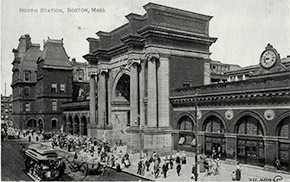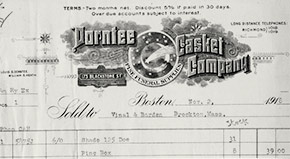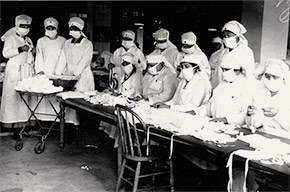Produced by the University of Michigan Center for the History of Medicine and Michigan Publishing, University of Michigan Library
Influenza Encyclopedia
The American Influenza Epidemic of 1918-1919:
A Digital Encyclopedia
Boston, Massachusetts
50 U.S. Cities & Their Stories
“Unless precautions are taken the disease in all probability will spread to the civilian population of the city.” Thus wrote Dr. John S. Hitchcock, the head of the communicable disease section of the Massachusetts State Department of Health in a circular to local health officials. It was September 5, 1918. The disease of which he wrote was influenza, currently felling sailors aboard the Receiving Ship at Boston’s Commonwealth Pier.1
Influenza had broken out at the Receiving Ship on August 28, and within a week there were over two-dozen cases among sailors stationed there. Soon, the disease spread to other nearby naval installations and shipyards, and by mid-September it had infected nearly two thousand of the 21,000 sailors stationed in the Boston area. With so many cases, medical officers struggled to procure adequate healthcare facilities. Under the direction of Colonel William H. Brooks of nearby Brookline, the Massachusetts National Guard erected a tent hospital on Corey Hill, completing the work in a single day. Two hundred sick sailors were admitted to the new emergency hospital the next day, September 10. Meanwhile, Chelsea Naval Hospital, just north of Charlestown, quickly filled with influenza patients, two-dozen of whom had already died from pneumonia caused by severe cases of influenza. The hospital at the immigration station on Gallups Island in Boston Harbor, with its 200 beds, was made available for influenza patients.2
Military officials did their best to stem the rising tide of cases and to protect the rest of the sailors and military personnel in the Boston area, as well as civilians. The approximately 2,500 non-ill sailors at Commonwealth Pier were relocated to tent barracks at the muster field in Framingham as a means of removing them from harm’s way. The 200 men enlisted in the Naval Aviation Service–expected to board a train for the training station at the Charleston Naval Yard in South Carolina–were kept in place so as not to transmit influenza to the South.3 It was a futile attempt, but there was little else naval officials could do. Meanwhile, Camp Devens, an Army installation of some 50,000 men and located just 45 miles northwest of Boston, was in the midst of its own massive epidemic.4 Boston was surrounded on all sides.
Sure enough, cases among Boston’s civilian population soon appeared. Initial civilian cases were reported on or about September 11. By September 16, there were hundreds of influenza cases in the city, causing overcrowding in both City Hospital as well as Massachusetts General. Six cases even appeared at the Charles Street jail, and countless more Bostonians were languishing in their homes.5 A total of 19 victims had died thus far; within a week that number would jump to 334.6
Because of the rapidity with which influenza had spread to and within Boston’s civilian population, local health experts assumed that the epidemic would quickly burn itself out with no interventions necessary. “I believe the plateau, if not the peak, of the contagion has been reached,” Boston’s health commissioner Dr. William C. Woodward–in office just seven weeks–told the public. “There is a chance that we shall continue at the same level until the first of the week and then a steady downward tendency may be expected.” He called on the public to avoid fatigue and crowds, and to remain at home and rest if sick.7 Although there were cases circulating in the schools, no deaths yet had been reported among children. Woodward therefore felt confident in keeping schools open for the time being.8 Boston’s member of the Executive Council, Lewis R. Sullivan, argued that influenza was entirely too contagious and dangerous to keep the schools open. “Last year the School Committee closed the schools in order to save coal,” he told the State House, “and it seems to me that they should now be closed in order to protect the health of the little pupils that don’t know how to protect their own health.”9 The medical director for Boston schools, Dr. W. H. Devine, disagreed, arguing that there was no reason for greater alarm than there had been the previous week. Furthermore, he believed Boston’s 100,000 students were safer in school, where trained nurses could examine them if they fell ill. Nevertheless, Boston School Superintendent Frank V. Thompson arranged to have all cases of influenza among students reported to his office as quickly as possible so that he could monitor the situation more closely.10
That situation was growing increasingly bleak. There were thousands of cases in and around Boston, with dozens of deaths occurring daily due to influenza and pneumonia. On September 24, Governor Samuel McCall held a conference call with the state Public Safety Committee, the Massachusetts Commissioner of Health, the United States Surgeon General, Health Commissioner Woodward, the manager of the New England Division of the American Red Cross, and representatives from nurses associations to discuss the dire situation in the state. The biggest issue: Massachusetts had been drained of physicians and nurses due to the calls for military service, and no longer had enough personnel to meet the civilian demand for healthcare. McCall issued a proclamation, asking every able-bodied person across the state with medical training to offer his or her aid in fighting the epidemic, and urging local authorities to close schools, places of amusement, churches, and other places where people gathered. Due to his absence from the state, McCall had Lieutenant Governor Calvin Coolidge sign the proclamation.11
With Governor McCall’s proclamation, Woodward and Boston school officials quickly changed their stance on issuing a closure order. Effective September 25, all public schools in Boston were closed indefinitely.12 Spurred to action by Governor McCall, and at the request of Woodward, Mayor Andrew J. Peters appointed a special Emergency Committee to advise and empower the health commissioner, to centralize command and allocation of the city’s healthcare resources, and to interface with state and other agencies.13 The Committee, headed by Woodward and staffed by Boston Public Safety Committee Chairman Victor A. Heath, the Superintendent of the Consumptive Hospital Dr. James J. Minot, Judge Michael H. Sullivan, and the Superintendent of the Instructive District Nursing Association Mary Beard, went to work immediately. At its first meeting, held on September 25, the Mayor’s Emergency Committee and state representatives recommended that all places of public amusement–theaters, movie houses, concert halls, lodges, concert halls, and the like–be closed indefinitely. Judge Sullivan suggested that teachers be recruited as nurses, and that Boston’s 265 school buildings, currently closed, be converted to temporary emergency hospitals.14 Meanwhile, Governor McCall made $100,000 ready through his Executive Council to be used to a statewide campaign against influenza.15
The next day, September 26, Woodward issued a closure order, shutting the doors of Boston’s theaters, movie houses, and dance halls, and prohibiting public gatherings until at least 7:00 am on October 7. The State Board of Health did not think that church closures were warranted, and so Woodward and the Emergency Committee only recommended that houses of worship close for at least the next ten days; the decision whether or not to do so was ultimately left to clergy. Only a few churches in the city opted to remain open for service on Sunday, September 29. Woodward felt that there was no way to regulate the use of public transportation, but urged the public to avoid unnecessary travel on streetcars, subways, or trains.16
The closure order was none too soon. Physicians and nurses were being over-worked, and hospitals were overflowing with desperate patients. Thirty-two nurses from Brigham Hospital were out sick with influenza themselves, unable to care for patients. The Homeopathic Hospital refused admittance to some 400 influenza patients. Temporary emergency hospitals were being set up in and around Boston to relieve some of the pressure, but the lack of doctors and nurses meant that there were precious few to take care of patients.17 To help allocate precious resources in the most efficient manner, Woodward established a hospital clearinghouse to keep track of daily hospital bed availability and distribute patients accordingly and to handle appeals for nurses and doctors. He also established a relief station in East Boston that was continually staffed with physicians and nurses. Woodward placed Boston’s health department nurses under the supervision of Mary Beard and the Instructive District Nursing Association so that they could be assigned duties more efficiently. The Consumptives’ Hospital Department did the same with its nurses, as did the Baby Hygiene Association, the School Committee, and area nursing schools.18 Many Boston and Cambridge teachers, released from their usual work due to the school closures and informed that they would be paid their regular salary if engaged in relief work, volunteered to aid the city’s nurses in combating the epidemic.19 The Providence Health Department sent six nurses to Boston to help their northern neighbor.20
Even with the extra help, Boston’s doctors nurses struggled to keep pace with the new cases the epidemic brought daily. One nurse recalled making nearly 100 home visits and tending for 500 patients during her four weeks of service. Another recalled visiting the home of a very sick husband and wife. The husband died, the doctor on the case brought the wife to his own home to recover. One never to be forgotten day at the height of the epidemic,” this same nurse remembered, “it seemed as if all the city was dying, in the homes serious illness, on the streets funeral processions.”21 The Boston Dispensary, a charitable medical institution founded in 1796 to give medical aid to the city’s poor, cared for over 2,000 influenza cases during the epidemic.22
In order to gain a better handle on just how bad the epidemic situation was, the Massachusetts Department of Health made influenza a reportable disease, effective October 2. All physicians as well as householders would heretofore be required to report influenza cases to their local health officials, who would then make regular reports to the state.23 Although the situation looked as if it might be improving–there was a slight dip in the number of deaths reported on October 2–Woodward extended the closure order until at least October 12, and education officials extended the school closure until at least October 14.24 On October 8, Woodward ordered all retail, department, dry goods, specialty, clothing, and furniture stores and shops to not open before 10:00 am or close before 6:15 pm, and asked business offices to close at 4:00 pm in an attempt to prevent crowding on public transportation.25 The Boston Elevated Railway Company, with over 700 of its platform employees out sick, pressed every car it could obtain into service to alleviate the crowding.26 Two days later, officials discovered that the new business hours had not worked as expected. Instead of reducing congestion, it simply shifted it to other hours. Woodward therefore allowed stores and shops to return to their normal business schedules.27
By mid-October, over 3,500 Bostonians had died from influenza or pneumonia since the start of the epidemic.28 Yet, there was hope. Death tallies had generally been decreasing in the past several days, leading Woodward and others to assert that the peak of the epidemic had passed. At midnight of Saturday, October 19, Boston’s closure orders were removed. Saloons, bowling alleys, poolrooms, theaters, and movie houses were allowed to reopen. Children would return to school on Monday, October 21. The District Nursing Association warned Bostonians that, despite the decrease in cases, there would likely be an even greater demand for nurses now that several hundred teachers and teaching nuns would be returning to their classrooms. Health authorities cautioned the public not to relax their guard against influenza lest the epidemic return to its former strength, however.29
The warnings went unheeded. After being closed for three weeks, theaters and movie houses opened to huge crowds. Lines formed hours in advance. Shows sold out quickly. Many theaters broke their attendance records as patrons filled the seats and then began standing in the aisles. Those who were unlucky enough not to get tickets flocked to cafes and hotels instead. Even the roads were crowded with carloads of Bostonians looking for some fun and a psychological respite from the death and chaos of the epidemic.30 As one reporter wrote, “Everything will be done today to make folks forget the epidemic and its awful price. For it was the epidemic which put the ban on Boston and made the city like a rural village without amusements or mirth.”31
The day after Boston reopened, Woodward announced to the city that the epidemic had officially passed.32 State health officials concurred, although they warned residents that influenza would continue to circulate to some extent throughout the winter.33 Residents breathed a collective sigh of relief, as did Boston’s overworked nurses and physicians. The Instructive District Nursing Association reported that, at the height of the epidemic, the city had 3,074 influenza cases, many of which required medical attention or nursing care. Over sixty percent of the Association’s nurses contracted influenza during the epidemic. Fortunately, only one died.34 The Red Cross Motor Corps reported that it carried nurses and physicians to and from cases on 5,880 calls during the epidemic, in addition to providing extra ambulance service for Boston City Hospital.35 The number of influenza cases had finally dwindled enough to allow city hospitals to begin scheduling surgeries again and to reopen their outpatient departments.36 In fact, the situation in Boston–and across Massachusetts–had improved sufficiently enough that the city could afford to send eleven of its nurses to Harrisburg, Pennsylvania for service there. “We still have need for nurses,” Massachusetts Commissioner of Health Eugene Kelley told the public, “but just at present Pennsylvania’s need seems greater than our own, and for that reason we are hastening to their aid, just as they came to our relief when we called for assistance several weeks ago.”37 A few days later, Kelley issued a public appeal for doctors and nurses to aid the people of Pennsylvania.38
As Thanksgiving approached, Boston experienced a slight rise in new influenza cases. Health experts attributed the increase to armistice celebrations, and asked residents to remain vigilant and to continue to avoid crowds and the ill whenever possible. Fortunately, these newer cases appeared to be milder. Woodward reminded Bostonians that, while the city’s epidemic was over, they could expect to see cases throughout the winter.39
Meanwhile, officials began to play the blame game as they tried to determine just why Boston’s epidemic had been so bad and why it was still continuing. Edward McSweeney, the chair of the Board of Trustees at Consumptives Hospital, sent a letter to Massachusetts governor Samuel McCall criticizing the state health commissioner for his failure to take early and decisive action in combating the epidemic and for attempting to place the blame at the feet of local health officers and agencies across the state.40 A Boston health department official attributed the recent increase in cases to “indiscriminate visiting to homes in which there are or have been persons ill with influenza.”41 Woodward believed it was all the coughing, sneezing, and even “forcible talking” occurring in crowds that was to blame, and he ordered signs printed to place all across the city to warn people to use better etiquette.42 He also blamed physicians for failing to report influenza cases, as required by state law.43 Many residents simply blamed Woodward and the city’s health department. In fact, the criticism was so strong that Mayor Peters briefly considered reorganizing the health department altogether.44 Instead, he created a panel of 11 prominent physicians to join Woodward to discuss all of the city’s health problems. At the top of the list for Woodward was dirty dishware used in restaurants and ice cream parlors.45
In reality, there was probably very little Boston could have done to have made its epidemic less severe. With the huge military presence in the area and with little warning of the impending doom, the city found itself in the midst of the epidemic before officials could react. Swifter action and more forceful leadership by Woodward and Mayor Peters may have mitigated some of the devastation, but the disease simply spread much too rapidly for an earlier closure order to have made much of a difference. Physicians and nurses quickly became overwhelmed with the sheer volume of cases, hospitals had more patients than beds, and even the Elevated had difficulty running with so many workers sick. Boston lost 4,794 of its residents to epidemic influenza and pneumonia in the fall of 1918 alone.46 Combined with the winter 1919 epidemic wave, Boston experienced an excess death rate of 710 per 100,000 residents, making it one of the worst hit cities in the United States. Only Pittsburgh and Philadelphia fared worse.47
Notes
1 “Fear Influenza Outbreak among Sailors May Spread,” Boston Globe, 6 Sept. 1918, 6. A receiving ship is an older vessel that is no longer seaworthy but can still float in calm waters, often used to house new sailors.
2 “Brookline Gets 200 Sick Sailors,” Boston Globe, 10 Sept. 1918, 7; “Falling off in Grippe,” Boston Globe, 12 Sept. 1918, 4; “Trying to Check Grippe,” Boston Globe, 14 Sept. 1918, 10.
3 “Trip Halted by Grippe,” Boston Globe, 14 Sept. 1918, 10.
4 “2000 Men at Devens Have Grip; Call for 40 Nurses and 10 Doctors at Bale Hospital,” Boston Post, 15 Sept. 1918, 18. The case tallies quickly increased. By the end of September, the peak month of the camp’s epidemic, Camp Devens had experienced 9,329 cases of influenza and 218 resultant deaths. See Maj. Genl. Merritte W. Ireland, ed., The Medical Department of the United States Army in the World War, Volume XV: Statistics, Part Two: Medical and Casualty Statistics (Washington, DC: Government Printing Office, 1925), 963, 979, 995, 1007. For an excellent account of the epidemic at Camp Devens, see Carol R Byerly, Fever of War (New York: New York University Press, 2005).
5 “Grippe Making Great Headway,” Boston Globe, 17 Sept. 1918, 1; “Six Influenza Cases at Charles St. Jail,” Boston Post, 14 Sept. 1918, 5.
6 “Spanish Grip Claims Nine,” Boston Post, 15 Sept. 1918, 1; “Death Rate for Boston Takes Rise,” Boston Post, 22 Sept. 1918, 4.
7 “Influenza is on the Wane,” Boston Post, 21 Sept. 1918, 5; “Death Rate for Boston Takes Rise,” Boston Post, 22 Sept. 1918, 4.
8 “Vigorous Action to Stamp out Grippe,” Boston Globe, 18 Sept. 1918, 3.
9 “Wants Boston Schools Closed,” Boston Globe, 20 Sept. 1918, 7.
10 “28 Deaths from Grippe in Boston,” Boston Globe, 19 Sept. 1918, 1; “Death Rate for Boston Takes Rise,” Boston Post, 22 Sept. 1918, 4.
11 “Governor Acts on Grippe Situation,” Boston Globe, 25 Sept. 1918, 2.
12 “State to War Upon Influenza, Governor Wants All Churches, Theatres and Schools Shut,” Boston Post, 25 Sept. 1918, 1.
13 Forty-Seventh Annual Report of the Health Department of the City of Boston for the Year 1918 (Boston: City of Boston Printing Department, 1919), 18.
14 “Boston Joins State in Fighting Grippe,” Boston Globe, 26 Sept. 1918, 5.
15 “State-Wide Call to Stop all Gatherings,” Boston Globe, 26 Sept. 1918, 1.
16 “Expect Now to Stop the Grip Epidemic,” Boston Post, 27 Sept. 1918, 1; “Rushing Doctors to Boston,” Boston Post, 28 Sept. 1918, 1.
17 “Rushing Doctors to Boston,” Boston Post, 28 Sept. 1918, 1.
18 Forty-Seventh Annual Report of the Health Department of the City of Boston for the Year 1918 (Boston: City of Boston Printing Department, 1919), 18-19.
19 “Cambridge Teachers,” Boston Post, 28 Sept. 1918, 11; “Grippe Conditions are Better All Over State,” Boston Globe, 3 Oct. 1918, 1.
20 “Providence Sending Six Nurses to Boston,” Boston Globe, 28 Sept. 1918, 4.
21 Recollections of Miss East and Miss Franklin, in Record Group 22.1, School of Public Health Nursing, Department of Nursing, Box 8, Folder 1, “Personal Experiences during the Outbreak,” Simmons College Archives, Boston, Massachusetts.
22 Report of the One Hundred and Twenty-Second Year of the Boston Dispensary (Boston: Geo. Ellis Press, 1919), 5.
23 “Marked Falling Off in Influenza Cases,” Boston Globe, 2 Oct. 1918, 1.
24 “Grippe Conditions are Better all over State,” Boston Globe, 3 Oct. 1918, 1.
25 “Grippe Toll Drops to 170 in Boston,” Boston Globe, 8 Oct. 1918, 1; “Epidemic Bans on for Fortnight,” Boston Post, 8 Oct. 1918, 1.
26 “Using Every Car it Can Man, Elevated Declares,” Boston Globe, 29 Sept. 1918, 10.
27 “Grip Epidemic is Decreasing,” Boston Post, 10 Oct. 1918, 1; “Grippe Death Toll Drops 20, t0 124,” Boston Globe, 11 Oct. 1918, 1.
28 “Influenza on Wane; Theaters to Reopen,” Boston Globe, 15 Oct. 1918, 1.
29 “Grippe Deaths in Boston Total 60,” Boston Globe, 19 Sept. 1918, 7.
30 “Crowds Jam All Theatres, Playhouses Reopen after Three Weeks of Idleness,” Boston Post, 21 Oct. 1918, 4.
31 “Joy-Killing Bans Lifted in Boston,” Boston Globe, 21 Oct. 1918, 1.
32 “Boston’s Epidemic Officially Ended,” Boston Globe, 22 Oct. 1918, 14.
33 “Marked Drop in Grip Cases,” Boston Post, 22 Oct 1918, 7.
34 “Grippe Deaths in Boston Down to 26,” Boston Globe, 24 Oct. 1918, 2.
35 C. C. Ely, A History of the Boston Metropolitan Chapter of the American Red Cross (Boston, 1919), 24.
36 “Grippe Deaths in Boston Drop to 19,” Boston Globe, 26 Oct. 1918, 4.
37 “Bay State Nurses Go to Harrisburg,” Boston Globe, 1 Nov. 1918, 5.
38 “Seek Doctors and Nurses Here for Pennsylvania,” Boston Globe, 3 Nov. 1918, 9.
39 “Influenza is in Mild Form, No Cause for Alarm Says Dr. Woodward,” Boston Post, 24 Nov. 1918, 9.
40 “Blames Kelley for Delay in Epidemic,” Boston Globe, 8 Dec. 1918, 11.
41 “Urges Precautions Over Christmas,” Boston Globe, 12 Dec. 1918, 16.
42 “Coughers, Sneezers, Talkers Dangerous,” Boston Globe, 19 Dec. 1918, 2.
43 “New Drive to Check Influenza’s Spread,” Boston Globe, 20 Dec. 1918, 14.
44 “Fewer new cases of influenza reported,” Boston Globe, 31 Dec. 1918, 4.
45 “Falling off in new cases of influenza,” Boston Globe, 23 Jan. 1919, 8.
46 Forty-Seventh Annual Report of the Health Department of the City of Boston for the Year 1918 (Boston: City of Boston Printing Department, 1919), 44.
47 Markel H, Lipman HB, Navarro JA, Sloan AJ, Michalsen JR, Stern AM, et al. Nonpharmaceutical interventions implemented by U.S. cities during the 1918-1919 influenza pandemic. JAMA. 2007; 298:647.
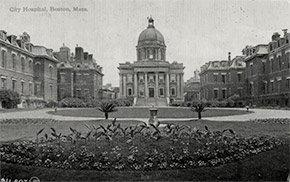 Click on image for gallery.
Boston’s City Hospital, established in 1864 for the treatment of the city’s poor.
Click on image for gallery.
Boston’s City Hospital, established in 1864 for the treatment of the city’s poor.
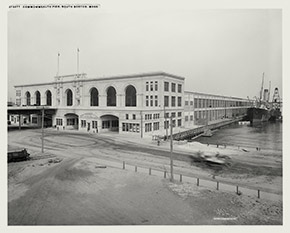 Click on image for gallery.
Commonwealth Pier, South Boston. The first influenza cases in the city appeared amongst sailors stationed here.
Click on image for gallery.
Commonwealth Pier, South Boston. The first influenza cases in the city appeared amongst sailors stationed here.
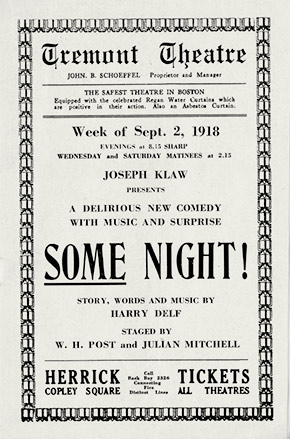 Click on image for gallery.
A program for the musical comedy “Some Night” at Boston’s Tremont Theatre. Once the closure order went into effect, this and all other shows were put on hold, leaving Bostonians with few outlets for entertainment.
Click on image for gallery.
A program for the musical comedy “Some Night” at Boston’s Tremont Theatre. Once the closure order went into effect, this and all other shows were put on hold, leaving Bostonians with few outlets for entertainment.
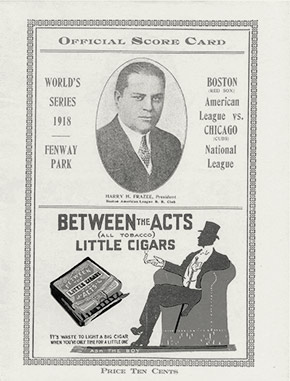 Click on image for gallery.
Official score card for the famous 1918 World Series between the Boston Red Sox and the Chicago Cubs. The series was played in early-September because of the war, as Boston’s influenza epidemic situation worsened dramatically. The Red Sox won, a feat they wouldn’t repeat for another 86 years.
Click on image for gallery.
Official score card for the famous 1918 World Series between the Boston Red Sox and the Chicago Cubs. The series was played in early-September because of the war, as Boston’s influenza epidemic situation worsened dramatically. The Red Sox won, a feat they wouldn’t repeat for another 86 years.
